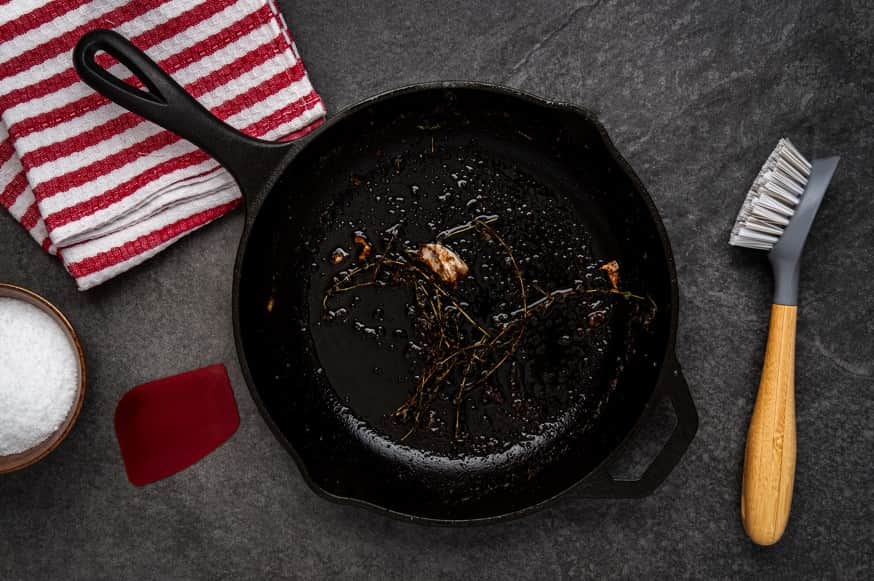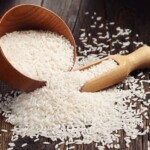This post may contain affiliate sales links. Please read my disclosure policy.

For many culinary enthusiasts, a cast-iron skillet isn’t just a kitchen tool; it’s an heirloom. The versatility, durability, and heat retention properties of these pans make them indispensable. Nonetheless, these pans demand unique care.
While you might think that you need a special cleaning agent or equipment to properly clean your cast-iron skillet, the truth is that you don’t need much more than hot water and elbow grease. In fact, some of the best ways to clean a cast-iron skillet are also the simplest.
Why Bother with Skillet Maintenance?
Your skillet is special. It’s made from a highly durable material that has amazing heat retention abilities, and it slowly develops a beautifully seasoned surface with each use.
This surface is not just a non-stick layer; it’s a character unique to your skillet. It’s like a culinary journal of sorts, remembering all the delicious meals that have sizzled upon it.
However, it needs your help to stay rust-free and to keep its seasoning, that’s the thin layer of cooked-on oil that gives it its non-stick properties.
The good news is that skillets are durable. They can last for decades if you take care of them properly. But, like anything else, if you don’t maintain it regularly, it will begin to show signs of wear and tear.
When that happens, your skillet will start to stick and it won’t be as easy to cook with. It will also lose that beautiful non-stick quality that you love so much. And who wants that?
How to Clean a Cast Iron Skillet
Get to it Right After Cooking
The best time to clean your skillet is right after you’ve used it. Simply rinse it with hot water and scrub it gently with a soft sponge. Don’t use soap as it’ll take off the seasoning.
You don’t need to scrub too hard, just enough to remove any food particles from the surface. If you do this when your skillet is still hot, it’ll be easier.
It’s worth mentioning that while you may be tempted to throw your skillet into the dishwasher or even soak it in water for some time, this isn’t a good idea. If you do, you’ll ruin the skillet’s seasoning. Something you definitely want to avoid.
But you might be wondering, what about stuck-on food?
Stuck-on food can be stubborn, but don’t reach for a steel wool or other abrasive. A mix of coarse kosher salt and water can make a gentle scrubbing paste that’ll get that residue off without damaging your skillet’s seasoning.
Dry It Well
Rust happens when your skillet is left wet. After washing, dry it off with a towel right away, and then let it warm up on a burner to get rid of any last bits of moisture.
Seasoning Your Skillet
Seasoning your skillet is what makes it non-stick. It’s just a layer of oil baked onto the surface of the skillet, and it protects your skillet from rust too.
To season your skillet, rub it all over with a thin layer of cooking oil, then bake it upside down in the oven at 350°F for about an hour. Let it cool down in the oven before you take it out. Do this every so often to keep your skillet’s seasoning fresh.
How to Care for Your Cast Iron Skillet
Caring for your cast iron skillet goes beyond cleaning and seasoning it; it’s important to get into good habits too.
Here are a few things you can do:
Use It
Regular cooking can actually help maintain your skillet’s seasoning. The oils and fats used in your recipes contribute to the pan’s slick surface, reinforcing its non-stick nature.
When you’re cooking, try to use a wooden or silicone spatula, which are gentler than metal ones.
Avoid high heat as cast iron retains and distributes heat well. Moderate to low heat will often suffice, ensuring the skillet’s longevity by minimizing the risk of warping or cracking.
Avoid Foods That Can Damage the Seasoning
While cast iron skillets are renowned for their versatility, there are a few types of foods that you should steer clear of.
Acidic foods, such as tomatoes, vinegar, or lemon juice, are at the top of the “avoid” list. When cooked for long periods, these acidic ingredients can actually react with the iron, leading to a metallic taste in your food, and can also strip away the seasoning of your pan. This can degrade the quality of your skillet over time, making it less non-stick and more prone to rust.
Delicate fish, such as tilapia, flounder, or sole, can be tricky in a cast iron skillet, especially if it isn’t well seasoned. These types of fish are so tender that they often stick to the pan and can easily break apart. If you’re set on cast-iron fish cookery, aim for sturdier species like salmon or tuna.
Similarly, foods prone to sticking like eggs or crepes might not be the best choice for a cast iron skillet, especially if it’s not well-seasoned. Without that non-stick surface, you’ll have a tough time flipping your breakfast, and cleaning the skillet can be a chore.
Desserts and other sweet dishes that require precision in temperature control can also be challenging to bake in a cast iron pan. Cast iron retains and distributes heat extremely well, which is wonderful for searing steaks but less ideal for a fluffy cake or pie crust that requires delicate heat.
Store Your Skillet Properly
The way you store your cast iron skillet is as vital as how you clean it. Cast iron can rust when exposed to moisture, so always ensure your skillet is bone dry before putting it away. It’s even recommended to heat it briefly on the stove to evaporate any remaining moisture after hand drying.
Avoid storing lids on the skillet as trapped moisture can encourage rust. If you need to stack your cookware, place a layer of paper towels between each item to prevent scratching and absorb any lingering moisture.
By storing your skillet in a cool, dry place, you’ll significantly increase its lifespan and maintain its superior cooking performance.
Benefits of Using a Cast Iron Skillet
Durability
A well cared for cast iron skillet can literally last for generations. These skillets are incredibly hard-wearing and resilient. They can handle high heat and almost any cooking method you throw at them. And even if they do start to show their age, they can almost always be restored to their former glory.
Unparalleled Heat Retention and Distribution
Let’s start with one of the most important features. Cast iron skillets are fantastic at holding onto heat and distributing it evenly. This means no hot spots or unevenly cooked food. When you heat up a cast iron skillet, it stays hot.
The heavy weight and thick walls of the skillet prevent heat from escaping, so it will stay hot for a long time. This makes it perfect for searing meat or sautéing veggies.
It also makes it great for baking because you don’t have to worry about your cake burning before the center cooks through.
Non-stick with Proper Seasoning
Cast iron skillets come with their own natural non-stick surface that gets better with age. This non-stick property comes from seasoning the skillet, which involves baking a layer of oil onto the surface. Over time, the surface becomes smoother and more non-stick.
Boosting Iron Intake
This might not be the first thing you think about when you use a skillet, but cooking in cast iron can actually increase the iron content in your food. This is a great bonus for anyone who needs to boost their iron intake.
Cost-Effectiveness
Despite all the wonderful benefits of cast iron skillets, they are generally quite affordable compared to many other types of cookware. Plus, considering their longevity, you get fantastic value for your money.
Final Thoughts
Cast iron skillets are a great addition to any kitchen. They offer a range of benefits that make them well worth the investment. And with proper care and maintenance, they can last for years to come.




